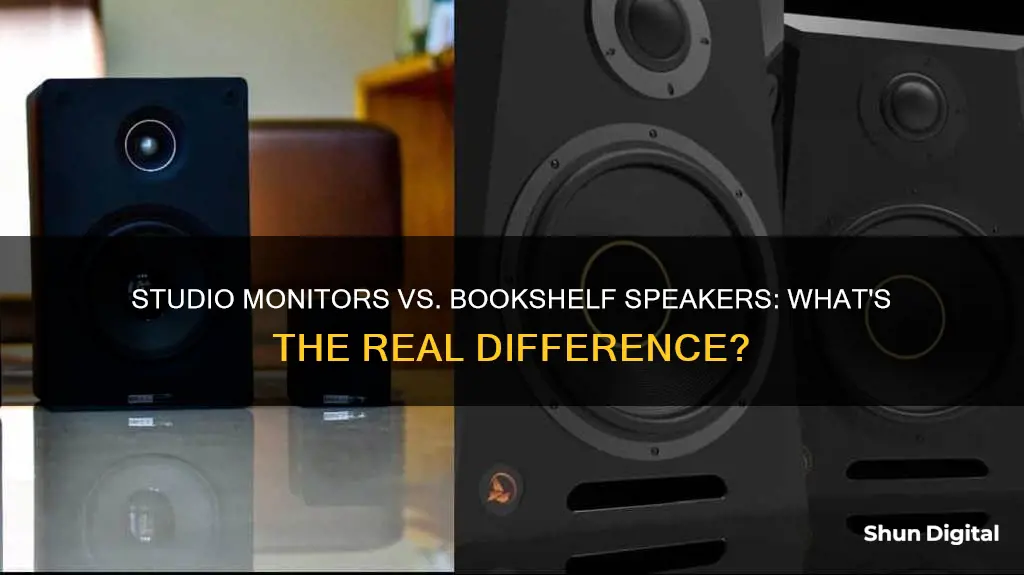
Studio monitors and bookshelf speakers may look similar, but they are designed for different purposes and behave differently. Studio monitors are used for professional audio production and are designed to have a flat frequency response, allowing for accurate sound reproduction. They are typically used in shorter-distance, studio settings and have built-in amplifiers. Bookshelf speakers, on the other hand, are designed for personal, home listening and have a wider coverage area and higher sound output. They are often coloured to sound a specific way and are meant to be listened to from various distances.
What You'll Learn
- Studio monitors are designed for professional audio production, bookshelf speakers are for personal listening
- Studio monitors are built for critical listening, bookshelf speakers are meant to sound good
- Studio monitors are active speakers, bookshelf speakers are passive
- Studio monitors are designed for shorter distances, bookshelf speakers are for various distances
- Studio monitors have built-in amplifiers, bookshelf speakers don't

Studio monitors are designed for professional audio production, bookshelf speakers are for personal listening
Studio monitors and bookshelf speakers may look similar, but they are designed for different purposes. Studio monitors are designed for professional audio production, while bookshelf speakers are for personal listening.
Studio monitors are used in the recording, mixing, and mastering process in studios. They are designed to have a flat, precise sound, so audio engineers can identify and correct any errors during recording. This flat frequency response means all audio frequencies are reproduced at the same level, providing a "spotless mirror" of the original sound. Studio monitors are also designed for shorter listening distances, typically around three feet away from the user.
Bookshelf speakers, on the other hand, are designed for a more personal, home listening experience. They focus on playing back audio in a way that sounds pleasant. They have a wider coverage area and higher sound output than studio monitors. Bookshelf speakers are designed to be listened to from various distances, both far and short. They often have features that enhance the listening experience, such as bass boost or EQing.
In terms of technical differences, studio monitors tend to be active speakers, with built-in power amplifiers, while bookshelf speakers are usually passive, requiring an external amplifier. Studio monitors often have multiple power amplifiers in one unit, allowing for individual power to the woofer, midrange, and tweeter cones, resulting in a more precise sound.
Additionally, studio monitors have specific input connectors, such as XLR, 1/4" Jack, or RCA, which are commonly used in professional audio settings. Bookshelf speakers, on the other hand, typically use banana-plug inputs, which are more common in home audio systems.
Mateo's Ankle Monitor: A Story of Surveillance and Intrigue
You may want to see also

Studio monitors are built for critical listening, bookshelf speakers are meant to sound good
Studio monitors and bookshelf speakers may look similar, but they are designed for different purposes and behave differently. Studio monitors are built for critical listening, bookshelf speakers are meant to sound good.
Studio monitors are designed for professional audio production in commercial or home studios, where accurate sound reproduction is crucial for recording or mixing. They are meant to sound "bad" so that you can pick out sonic imperfections and fix them. Studio monitors are designed to have a flat, precise sound for near-field use. This means they don't emphasise any one frequency, giving you the most accurate impression of your mix so that you can easily identify imperfections. Studio monitors are also normally meant for close-up listening, usually a few feet away from the user.
Bookshelf speakers, on the other hand, are designed for a more personal, home listening experience with a key focus on playing back audio in a pleasant way. They are meant to sound good from various distances, far or short, and in any space. Powered speakers are often "coloured" to sound a particular way by design. They are optimal for room-filling audio as they are designed to carry sound and offer a distortion-free option for social gatherings and home audio.
Studio monitors tend to be active, meaning they have built-in power amplifiers. They also have multiple power amps in one unit, so the woofer (bass), midrange and tweeter (treble) cones are each powered individually, making for a more precise sound. Bookshelf speakers, meanwhile, are generally passive, receiving power from a dedicated standalone amplifier.
Studio monitors are also bi-amplified or tri-amplified, meaning the audio frequencies are separated into bands by an active crossover and then amplified individually for accuracy and efficiency. They also have professional-grade balanced input connectors such as XLR, 1/4" Jack, or RCA. Bookshelf speakers tend to have banana-plug inputs, which are more common in the home audio sector.
Performance Monitor Mastery: Reading Basics to Advanced Tips
You may want to see also

Studio monitors are active speakers, bookshelf speakers are passive
Studio monitors and bookshelf speakers may look similar, but they are designed for different purposes and behave differently. Studio monitors are typically used for professional audio production and are meant to be listened to from shorter distances, whereas bookshelf speakers are designed for personal, home listening and can be listened to from various distances.
Studio monitors are active speakers, meaning they have built-in power amplifiers. This makes them convenient and cost-effective for studio use. They also tend to have multiple power amplifiers in one unit, powering the woofer, midrange, and tweeter individually for a more precise sound. Studio monitors are designed to have a flat, precise sound, allowing audio engineers to make better mix decisions and correct any errors during recording. They are meant to sound "bad" so that you can identify and fix sonic imperfections.
On the other hand, bookshelf speakers are passive speakers, meaning they require external power from a dedicated standalone amplifier. They are designed to sound "good" and provide a pleasant listening experience. Bookshelf speakers are coloured to sound a specific way and often have a wider coverage area and higher sound output. They are ideal for filling a room with sound and are suitable for social gatherings, home audio, and home theatre listening.
When choosing between studio monitors and bookshelf speakers, consider your specific needs and application. Studio monitors are suitable for professionals in audio production, such as sound engineers, musicians, and DJs, who require accurate sound reproduction for recording, mixing, or mastering audio. Bookshelf speakers are a better choice for music lovers, audiophiles, or home theatre enthusiasts who want high-quality sound reproduction for personal listening.
LCD Monitor Flicker: Why It Happens and Solutions
You may want to see also

Studio monitors are designed for shorter distances, bookshelf speakers are for various distances
Studio monitors and bookshelf speakers may look similar, but they are designed for different purposes and have distinct features. Studio monitors are designed for professional audio production and critical listening in commercial or home studios, where accurate sound reproduction is crucial for recording, mixing, editing, and mastering. On the other hand, bookshelf speakers are designed for a more general purpose of personal, home listening with a focus on sound quality and coverage area.
Studio monitors are designed for shorter distances, typically for near-field use, which means they are meant to be placed a few feet away from the listener in a studio setting. This close proximity provides a clear, immediate, and precise sound, preventing natural reverberations from affecting the audio. Studio monitors aim to produce a flat frequency response, where all audio frequencies are reproduced at the same level, creating a "blank canvas" for audio engineers to work with. This flat response allows for critical listening, making it easier to identify sonic imperfections and make accurate mix decisions.
Bookshelf speakers, on the other hand, are designed for various distances, catering to both short and far-field use. They are meant to be versatile, providing a pleasant listening experience regardless of the listener's position in the room. Bookshelf speakers often have a wider coverage area and higher sound output to accommodate different listening distances. They are designed to sound good and meet the needs of the user, with an emphasis on creating an enjoyable listening experience.
In terms of sound, studio monitors prioritize flat-response, maintaining the 'true' frequencies of the audio without enhancing or colouring the sound. This flat response is intentional, as it allows for accurate reproduction and critical listening. Bookshelf speakers, however, may be coloured to sound a particular way by design. They often enhance the sound with rich bass and high frequencies, creating a more exciting and dynamic listening experience.
The physical design of studio monitors and bookshelf speakers also reflects their intended use. Studio monitors often have built-in amplifiers, individual volume controls, and low-frequency cut options to compensate for the acoustics of the room. They typically use XLR or TRS connectors, which are common in studio settings. Bookshelf speakers, designed for home audio, usually have the amplifier built into the receiver or as a separate component and use banana-plug inputs, which are more common in home audio systems.
Monitoring App Bandwidth: A Comprehensive Guide to Track Usage
You may want to see also

Studio monitors have built-in amplifiers, bookshelf speakers don't
Studio monitors are designed for use in professional audio production settings, where accurate sound reproduction is crucial for recording or mixing. They are typically used in shorter-distance, studio settings. Studio monitors usually have built-in amplifiers, and they tend to be active speakers. This means that they have multiple power amplifiers in one unit, powering the woofer, midrange, and tweeter individually for a more precise sound.
Bookshelf speakers, on the other hand, are designed for a more general purpose and can be listened to from various distances, typically in a home setting. They do not usually have built-in amplifiers; instead, they receive power from a dedicated standalone amplifier.
The presence of built-in amplifiers in studio monitors offers several advantages. Firstly, it simplifies the setup process by reducing the number of external components required. Secondly, it ensures that the speakers have a consistent and reliable power source, which is crucial for accurate sound reproduction. Finally, built-in amplifiers in studio monitors are designed to work optimally with the specific speaker components, resulting in improved sound quality and precision.
The absence of built-in amplifiers in bookshelf speakers, however, offers its own set of advantages. By using a dedicated external amplifier, users have more flexibility in customizing their audio setup. They can choose an amplifier that suits their specific needs and preferences, whether it be for music, movies, or gaming. Additionally, external amplifiers often provide more power and can drive the speakers to higher volumes, making them suitable for larger spaces.
Cutting Off: Removing Electronic Monitoring Bracelets Illegally
You may want to see also
Frequently asked questions
Studio monitors are designed for professional audio production in commercial or home studios, where accurate sound reproduction is crucial for recording or mixing. Bookshelf speakers are designed for a more personal, home listening experience with a key focus on playing back audio as a pleasant listening experience, with a wider coverage area and higher sound output.
Studio monitors are great for critical listening, recording, radio studios and even television. They are also the best option for mixing, editing and mastering audio to a professional degree. Studio monitors are consistent, featuring a natural playback of most recorded material.
Bookshelf speakers are optimal choices for room-filling audio. They are designed to provide, reinforce and carry sound, offering a distortion-free option for social gatherings, home audio, and home theatre listening.
Studio monitors, particularly near-field monitors, are designed to sound good from a specific distance and perspective. If you move around the room, the sound will change quite a bit. This is generally considered an unattractive trait for home listening.







